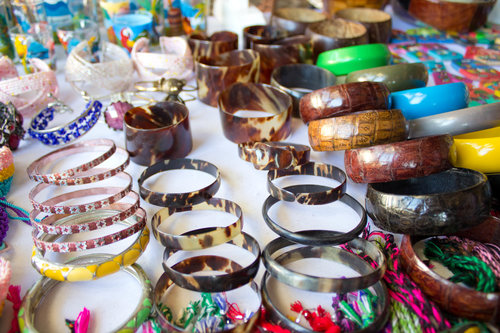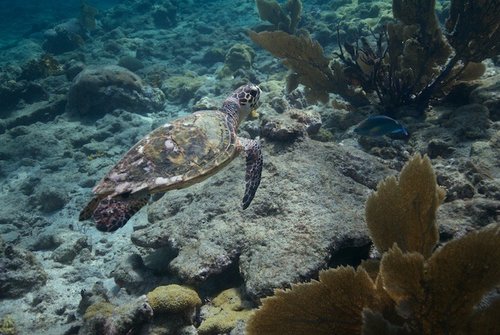
Several years ago, Brad Nahill, co-founder of ecotourism organization SEE Turtles*, was shopping for souvenirs in San Juan del Sur, Nicaragua when he noticed something rather troublesome.
“I was shocked to see how many [turtleshell products] were being sold in the souvenir shops and artisan stands around town,” Nahill said.
Shocked at how prevalent the sale of turtleshell products were he decided to study the issue in depth and much to his dismay, Nicaragua was not the only guilty party.
Nahill’s findings inspired him to launch Too Rare to Wear, a coalition of primarily conservation organizations and tour operators that are fighting to cease the sale of turtleshell products to travelers in Latin America in order to protect the endangered hawksbill sea turtle.
In Cuba, hawksbill shell products are available in almost 70% of souvenir shops. A five-year study in Cartagena, Colombia, revealed an average of more than 2,000 hawksbill shell items sold annually by a group of vendors.
“Nicaragua’s problems are similar to those in the Greater Caribbean,” says Karla Barrientos, the scientific director of La Fundación Tortugas de Mar in Colombia.
“The similarity between Colombia and Nicaragua is that both countries are leaders in the trade of hawksbill crafts and they lead share maritime border limits, so possibly the handicrafts sold in both places are part of the same population of hawksbills in the Caribbean.”
However, Barrientos adds while hawksbill crafts are sold for rather low prices in Nicaragua, in Colombia, these handicrafts have a much greater monetary value to the point that the country is responsible for more than 40% of the total sales of handicrafts of the nine countries examined by Too Rare to Wear.
Endangered

Found in every ocean except the Arctic, hawksbill sea turtles are endangered. Despite their protected international status, they are often killed for their flesh and shells, in addition to being at risk for accidental capture in fishing nets.
For Nahill, the desire to preserve the hawksbill sea turtle isn’t a newfound passion.
“I first fell in love with these animals when I went to Costa Rica after graduating from college to volunteer with a leatherback turtle conservation project on the Pacific coast,” he says.
“I didn’t know much about these animals before I went but from the first moment I saw a six-foot long, 800-pound turtle that looked like a dinosaur crawl from the ocean, I fell in love. The more I learned about them, their unique role in the ocean, and the threats that they face, the more I realized that working to protect them was what I wanted to do with my career.”
Fortunately for Nahill, many others are willing to join the fight. “When we launched Too Rare to Wear, we already knew many tour operators who proactively work to protect the places and animals where their customers go,” he adds.
In fact, since the campaign was launched more than forty tourism companies have joined SEE Turtles to spread word about hawksbill sea turtles via social media and their websites.
One of those people willing to join the fight is David Melero, Executive Director of SOS Nicaragua, who views tourism as a means for conservation. At least 50% percent of SOS Nicaragua’s revenues are directed towards hawksbill conservation efforts.
“Someone needs to be blind to not notice that there are turtleshell products in almost every souvenir shop in the country,” says Melero.

“We are supporting the hawksbill project in Nicaragua to open up participation to active donors that come from all around the world and donate time and funds in exchange for an unparalleled experience, ” he adds.
Despite being endangered, progress has been made in protecting hawksbill sea turtles. In Colombia, Barrientos says the La Fundación Tortugas de Mar has received assistance from outside sources, such as law enforcement agencies who have seized hawksbill sea turtle products.
“When law enforcement agencies understand why they should care for hawksbills, their commitment is greater,” Barrientos says. She adds, due to the work of the Environmental and Ecological Police in Colombia, the sight of hawksbill crafts in the streets are not as common as they were nine years ago.
Who else can help?
Meanwhile, Nahill speaks glowingly of an award-winning network of conservation organizations called ICAPO (Eastern Pacific Hawksbill Initiative) which has been able to launch numerous efforts to reduce threats to the population of hawksbills. Hotels on nesting beaches, in particular, contribute to the preservation of hawksbill sea turtles.
“Now that the major nesting beaches are well-protected, efforts to reduce the number of turtles affected by fishing have been launched, and there is now hope for these hawksbills,” he adds.
“Hotels need to be set back far enough to leave room for the turtles to nest, especially for hawksbills who tend to nest very high up on the beach or in vegetation,” advises Nahill. “Hotels also need to control lighting on the beach since light repels nesting females.”
But tourism companies are not the only ones who can contribute to the creatures’ preservation.
“The biggest thing that travelers can do is educate themselves about turtleshell jewelry and learn how to avoid it,” says Nahill. “And when they do find it, not to purchase anything from that shop or vendor.”
Travelers can do more than simply not buy turtleshell jewelry—Nahill thinks spreading word about the reasons not to buy turtleshell souvenirs is a valuable step. And better yet, Nahill advises travelers to visit turtle conservation projects and either volunteer with them or donate to turtle conservation efforts.
But how do you educate travelers about the issue? Melero admits it’s a “challenge.”
“People need to know first,” he says. “If they have the information, they know the importance and the threats that hawksbill sea turtles are facing, maybe – only maybe – we can do a real awareness campaign.”
Nahill has experienced the same challenges.
“We’re still working through the challenges of educating travelers and how to overcome them but primarily the issue is one of effectively reaching consumers with so much competition for their attention,” he explains.
“That is partially a funding issue but by bringing tour operators into the coalition who are communicating to travelers heading to the region, we are able to reach them at a low cost.”
Ethical Traveler hopes this message spreads quickly through the ethical traveling community.
*Disclosure: Ethical Traveler co-founder Michael McColl completed a consulting project for SEE Turtles in 2011.
Read Ethical Traveler's Reprint Policy.
